The green power of fungi
They are used as medicines, drug carriers and to combat microbes in hospitals, destroy plant pathogens and reduce the amount of traditional fertilizers used in agriculture - nanoparticles are taking over medicine and the agri-food industry.
Nanoparticles are tiny structures up to 100 nanometers in size. They are characterized by different physical and chemical properties and biological activity than their larger material counterparts. - When the starting material on a micro-scale with a specific surface area is broken down to nano size, i.e. into smaller particles, its surface area will increase many times. And it is the ratio of surface to volume that results in the unique properties of nanoparticles, explains Prof. Mahendra Rai from Sant Gadge Baba Amravati University in India.
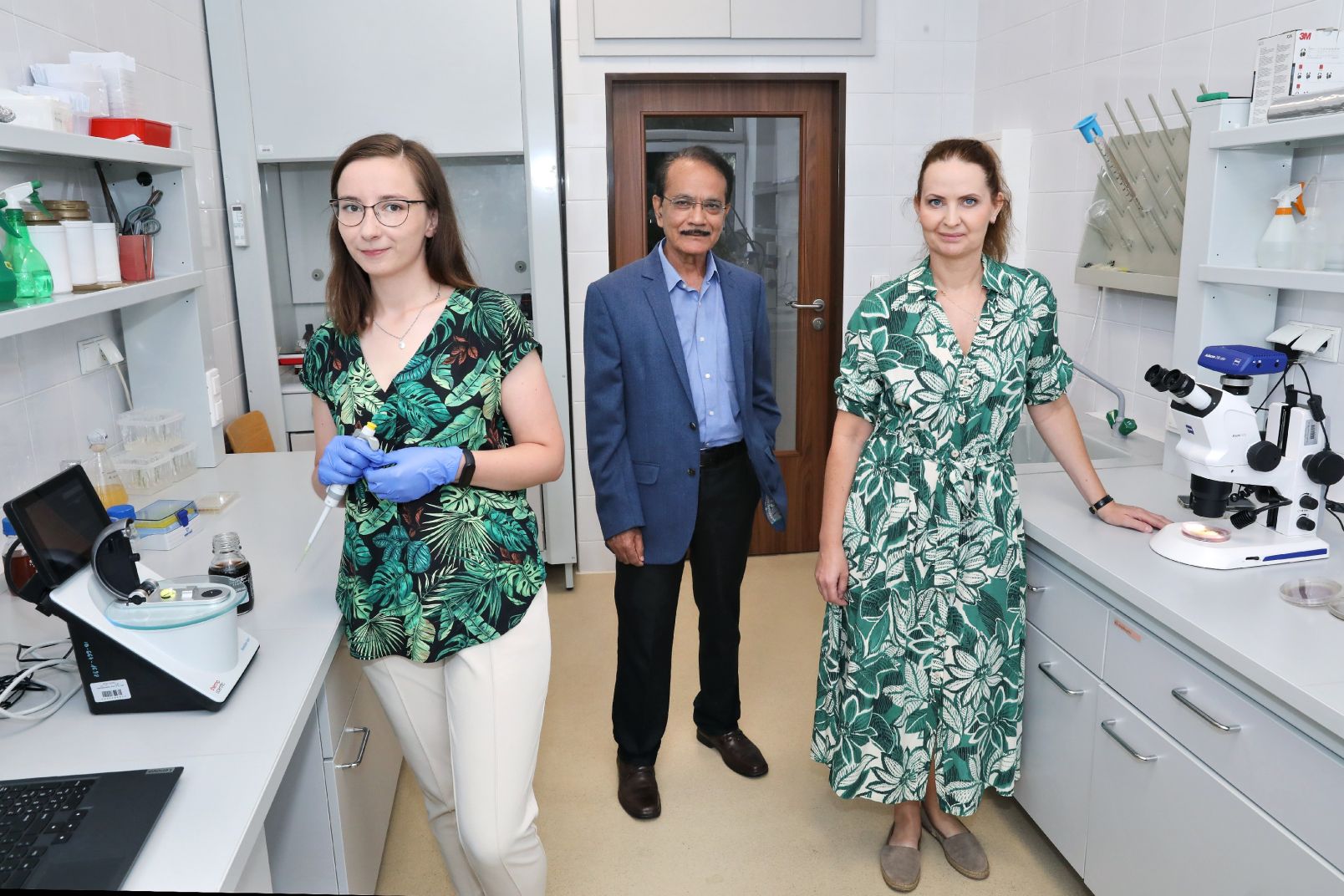
photo Andrzej Romański
Nanoparticles can be mainly organic or inorganic. Among the organic ones, we can distinguish e.g. liposomes, micelles, and dendrimers. - Liposomes are vesicles made of a phospholipid bilayer with free space inside, in which you can put, for example, a drug and precisely deliver it to the target place in the body because the liposomes will disintegrate in the acidic environment of the tumor and release the drug in it – says, prof. Patrycja Golinska from the Department of Microbiology at the Faculty of Biological and Veterinary Sciences NCU. – Among inorganic nanoparticles, we can distinguish nanoparticles of metals such as silver, gold, titanium, copper, metal oxides (e.g. zinc oxide) and semi-metals (metalloids) such as silica, selenium, and aluminium. At Nicolaus Copernicus University, we focused mainly on metal nanoparticles. So far, we have mostly biosynthesized silver and gold nanoparticles. In recent years, we have also biosynthesized nanoparticles of zinc, copper, and magnesium oxides.
Nanoparticles can be obtained in various ways, but in recent years, the so-called green synthesis (biological synthesis or biosynthesis) has attracted increasing interest in nanotechnology. - It is environmentally friendly. In biological synthesis, unlike chemical or physical synthesis, the production of nanoparticles does not use toxic compounds and does not consume large amounts of energy - informs Prof. Rai. In addition, after the production of nanoparticles in a chemical or physical way, they still need to be stabilized, i.e. "coated" with other chemical compounds, which are usually also toxic. The point is that the nanoparticles do not aggregate, i.e. do not combine with each other into structures of larger sizes and do not lose their reaction surface and thus their unique properties.
Green nanotechnology
Biologists from the Nicolaus Copernicus University in Toruń became interested in biosynthesis, i.e. the synthesis of nanoparticles by microorganisms such as fungi and bacteria, as well as by algae and plants. During the visit of Prof. Rai in Poland, scientists focused on mycosynthesis, i.e. the synthesis of nanoparticles using fungi. – As part of the project, which Prof. Rai carried out at the Nicolaus Copernicus University, we synthesized silver nanoparticles using fungi, mainly of the genus Fusarium, which infect plants, including cereals, but also from other genera like Penicillium, which develop e.g. on tangerines and lemons - says prof. Golinska. – In such production, no toxic compounds are used and no toxic waste is produced.
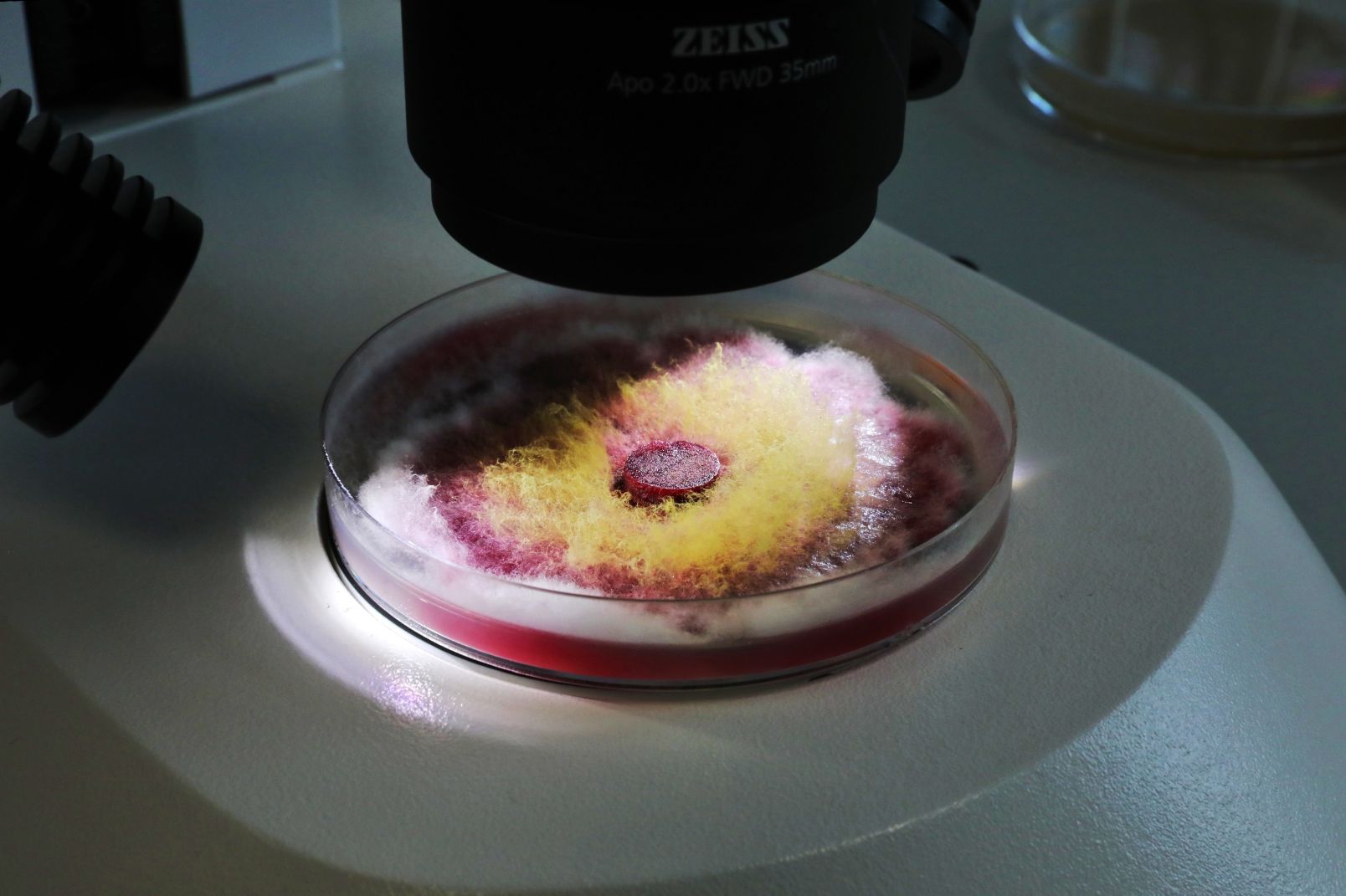
photo Andrzej Romański
The advantage of fungi over other microorganisms in the synthesis of nanoparticles is that they produce a large number of various metabolites, including many proteins, including enzymes, and many of these substances can be involved in the reduction of silver ions to nanosilver.
Applications
Nanotechnology can be used in the most important areas of human life: medicine, agriculture and the packaging industry, and food storage. Nanoparticles are highly active against various microorganisms. They fight pathogenic microbes very well and inhibit their spread, which can be used to produce various surfaces and materials in hospitals, such as masks with a nanosilver filter, which were created during the COVID-19 pandemic. They are effective against bacteria that are resistant to commonly used antibiotics. Silver nanoparticles also have anti-cancer properties.
Nanomaterials are smart, they can be administered, for example, intravenously, but they work at the target site, i.e. in a cancerous tumor, and not like chemotherapy, which is distributed throughout the body at the same time destroying both abnormal and healthy cells - explains Prof. Rai. In the case of nanoparticles, we can use targeted therapy, in which the anti-cancer drug will be released only at the site of the tumor. Nanoparticles themselves can be a drug, and also a drug carrier.
In agriculture, nanotechnology is used in three aspects. The first is the early detection of plant pathogens before the first symptoms of plant disease appear. The electronic nose is a technology that we do not deal with at the moment, but thanks to the use of nanomaterials such as nanowires or nanorods of zinc oxide in this device, it detects volatile substances produced by pathogenic fungi. Other types of nanobiosensors detecting the DNA of plant pathogens can also be used, says Prof. Golinska. - Thanks to this, appropriate agrotechnical treatments can be applied before we see the symptoms of plant infestation, e.g. discoloration, raids or necrosis of leaf blades.
The second aspect is the use of a solution of nanoparticles to directly combat pathogens that have already developed on plants. Such nanoparticles usually act at much lower concentrations than chemical fungicides, so their concentration in the environment is also much lower compared to commonly used fungicides.
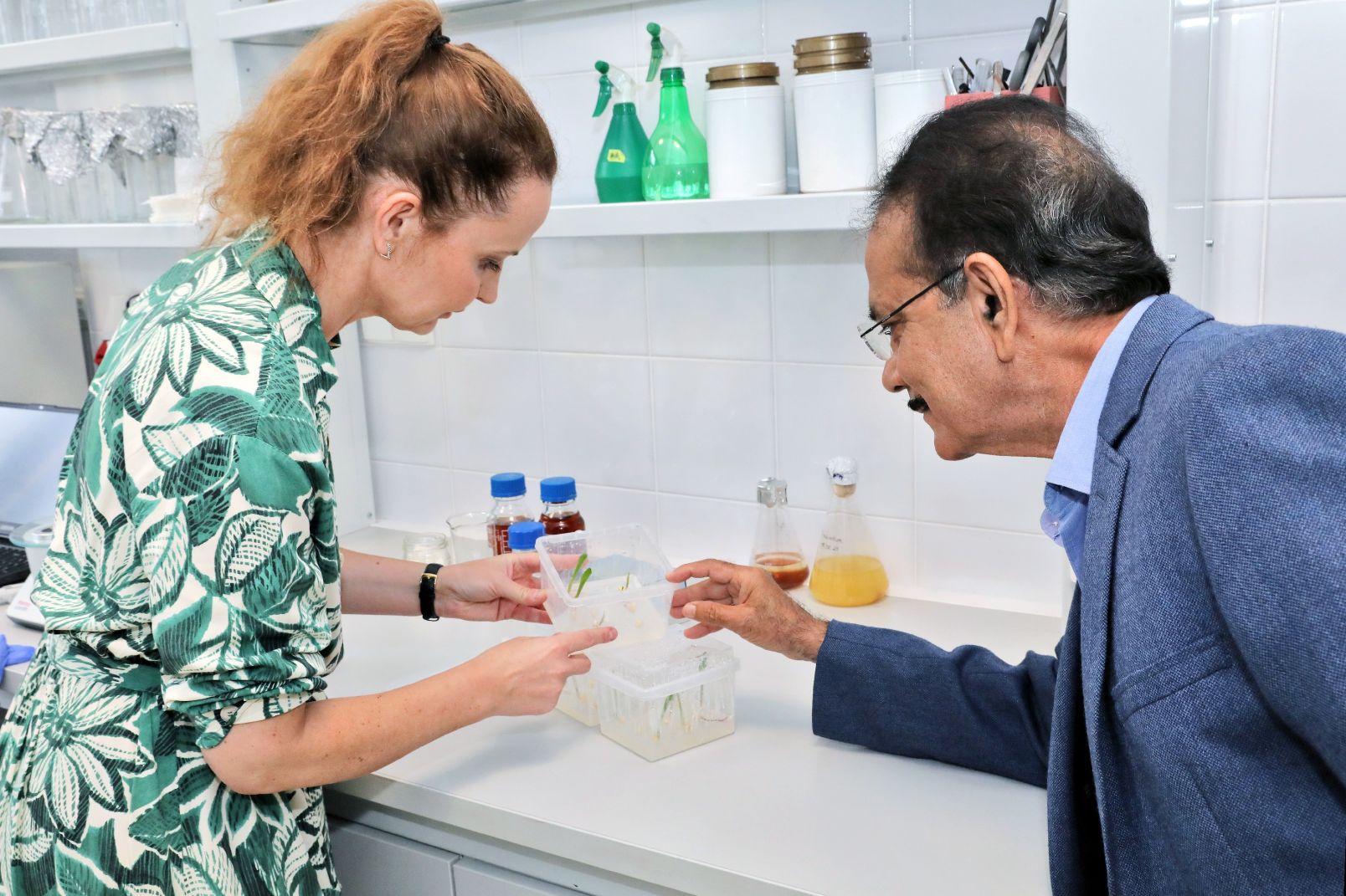
photo Andrzej Romański
The third area of application of nanomaterials in agriculture is the delivery of nutrients to plants. As in medicine, nanomaterials themselves can be a nutrient or a carrier containing a nutrient that can be released in a controlled manner. When farmers use traditional fertilizers, they deliver a huge amounts of them to the fields in a short time, which plants are unable to use and a large part of them penetrates deep into the soil to groundwater and, consequently, to water reservoirs (surface water). This adversely affects the aquatic environment leading to its eutrophication. Excessive fertilization also harms soil microorganisms and leads to the so-called. "Soil fatigue", i.e. a constant imbalance in the content of nutrients, which negatively affects the size of crops.
Using nanoencapsulation, i.e. placing nanoparticles that are nutrients for plants in capsules or matrices, you can apply these nutrients by foliar or soil application – says Prof. Rai. The biggest advantage of this solution is the release of nutrients in a controlled, slow and constant way. This is an element of sustainable development, which is extremely important nowadays.
Friendly fungi
Prof. Rai came to Poland for two years thanks to a scholarship he received from the Polish National Agency for Academic Exchange (NAWA). Under the proposed project, "Development of new environmentally-friendly and biologically active nanomaterials" together with a team consisting of Dr hab. Patrycja Golińska (prof. of NCU), Dr Magdalena Wypij, and PhD student Joanna Trzcińska-Wencel, dealt with the production of nanocomposites based on pullulan and silver nanoparticles (AgNPs) for combating various microorganisms.
Pullulan, a natural biodegradable polymer, was biosynthesized using fungi (Aureobasidium pullulans) and combined with silver nanoparticles, produced by green synthesis using mold fungi, which I mentioned earlier - explains Prof. Golińska, and we created films, i.e. thin and flexible foils, encrusted with silver nanoparticles. We tested these films, for example, to combat pathogens responsible for wound infections or those that develop in food, such as Listeria monocytogenes or Salmonella sp., i.e. de facto to extend the shelf life of food.
Pullulan incorporated with silver nanoparticles presents beneficial properties and therefore could be used, for example, in the production of food packaging or dressings which accelerate the healing of wounds, protecting them against the development of infection. - When we have more extensive wounds, e.g. burns, they are highly exposed to the development of infection - explains Prof. Golińska - Securing such a place with a biodegradable polymer with an agent inhibiting the development of pathogens will significantly accelerate wound healing.
The team intends to patent a method for obtaining pullulan-based nanocomposites and releasing nanoparticles from the film. Morover, Prof. Rai and Prof. Golińska edited three important books: "Microbial Nanotechnology", "Myconanotechnology: emerging trends and applications" and "Mycosynthesis of Nanomaterials: Perspectives and Challenges" published by the prestigious publishing house CRC Press/Taylor and Francis Group. “We hope that these books will open up new possibilities in the field of environmentally friendly green nanomaterials," says Prof. Rai.
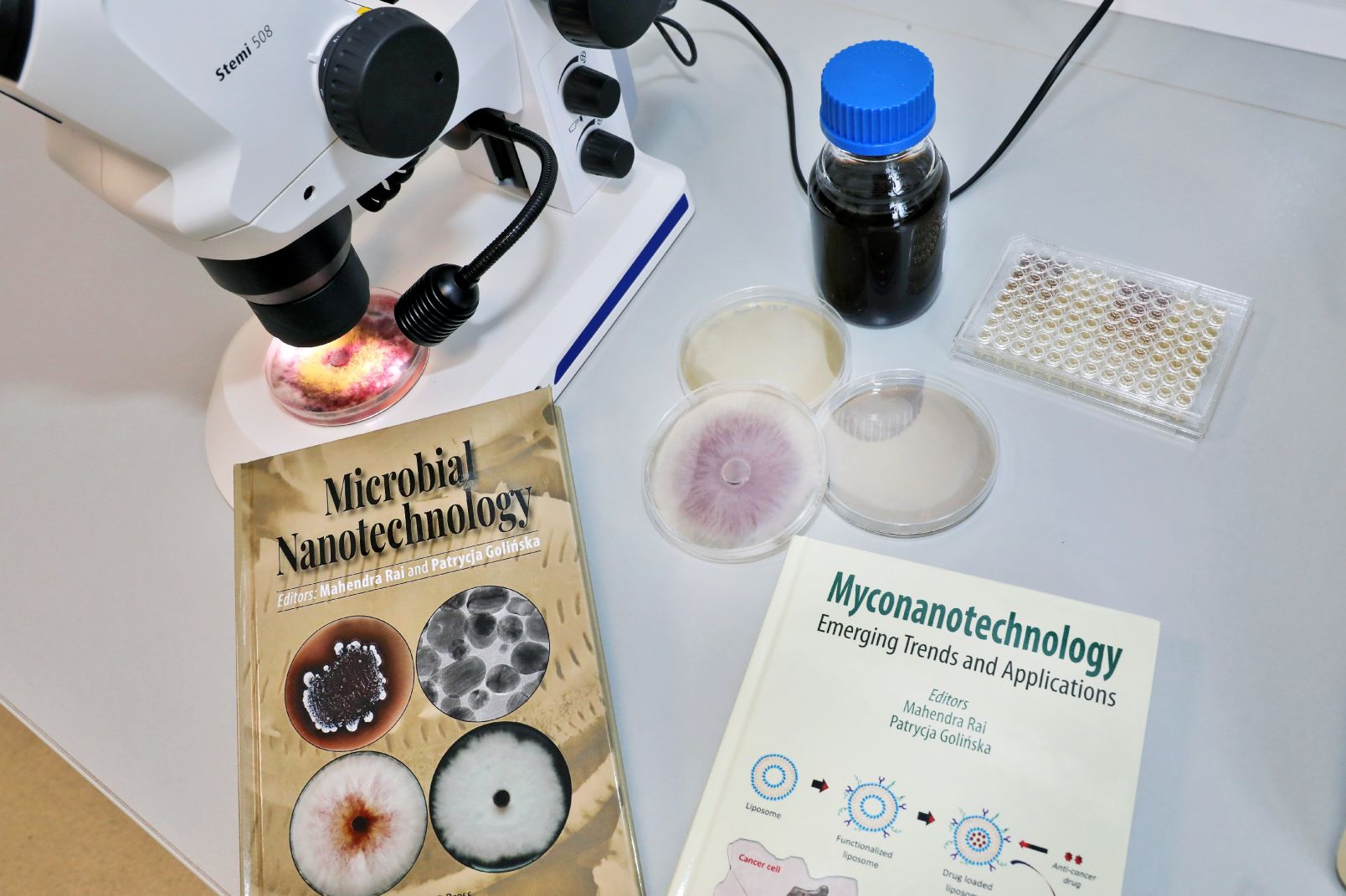
photo Andrzej Romański
In addition, two research papers were published during the professor's visit, namely “Biogenic nanosilver bearing antimicrobial and antibiofilm activities and its potential for application in agriculture and industry" and “Superior in vivo wound-healing activity of mycosynthesized silver nanogel on different wound models in rat" and another two "Biofabrication of novel silver and zinc oxide nanoparticles from Fusarium solani IOR 825 and their potential application in agriculture as biocontrol agents of phytopathogens, and seed germination and seedling growth promoters" and “Pullulan-based films impregnated with silver nanoparticles from Fusarium culmorum strain JTW1 for potential applications in food industry and medicine" were published just after Prof. Rai left from Poland. Another measurable effect of the cooperation of Prof. Rai with Prof. Golińska will be a visit to the Nicolaus Copernicus University of Dr. Aniketkumar K. Gade who received the grant from National Science Centre of Poland in the Polonez Bis 2 call, under which he will be employed for 24 months as an associate professor and come to Toruń in October. He will also implement a project related to the application of nanotechnology in agriculture. He will produce bionanoparticles encapsulated with casein, which will be used as fertilizer in the future.
The goal of the research team working at Nicolaus Copernicus University is to create nanoformulations used as nanofertilizers and agents for controlling the development of plant pathogens, which can be widely used in agriculture to replace chemical fertilizers and plant protection products currently used in a large amount. – This is to limit the use of chemicals in agriculture, lead to sustainable development and mitigate the effects of the changing climate – says Prof. Rai.
The collaboration of Prof. Rai with the Nicolaus Copernicus University in Toruń has been going on for several years. In 2009, Prof. Rai invited Prof. Dr hab. Hanna Dahm, then head of the Department of Microbiology at NCU, to contribute a chapter on "Ectomycorrhiza and secondary metabolites" in the monograph "Diversity and Biotechnology of Ectomycorrhizae", of which he was the editor. Prof. Golinska was involved in the manuscript writing. This is how we came in contact with Prof. Rai, but not personally - says Prof. Golinska. Three years later, when the scientist came to Toruń for a one month, as a visiting professor at Nicolaus Copernicus University, I was on a one-year scholarship in United Kingdom and unfortunately, we could not meet.
After returning from United Kingdom in 2012, Prof. Golińska became interested in nanotechnology and biosynthesis of nanomaterials. In 2013-2016 she collaborated with Prof. Rai in the interdisciplinary Symfonia 1 grant from the National Science Center, under which nanoparticles were biosynthesized using actinomycetes and used to combat various pathogens. During the implementation of the grant, Prof. Rai visited Toruń for a few days, and one of his students, Dr. D.P. Rathod came to Nicolaus Copernicus University for a one-year postdoc. During this period, many scientific papers/reviews were published. After habilitation in 2017, as an independent researcher, Prof. Golińska has continued her cooperation with Prof. Rai. In 2019, researchers submitted an application to NAWA under the Stanisław Ulam program, which allows recognized scientists to come to Poland in order to strengthen the scientific potential of Polish research units and their internationalization. Due to the COVID-19 pandemic, the professor's arrival was delayed. Finally, the scientist from India arrived at the Nicolaus Copernicus University in July 2021, and in July 2023 the scholarship and the researcher's stay in Toruń ended.
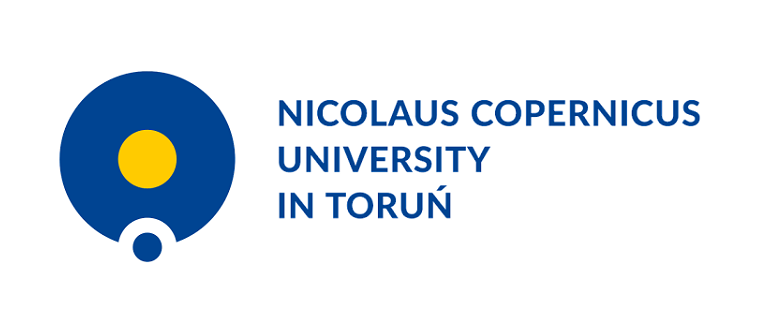 NCU News
NCU News







 Natural sciences
Natural sciences

